
- PROJECTS
- |
- ABOUT
- |
- INSPIRATION
- |
- TECHNOLOGY
- |
- PROCESS
Process
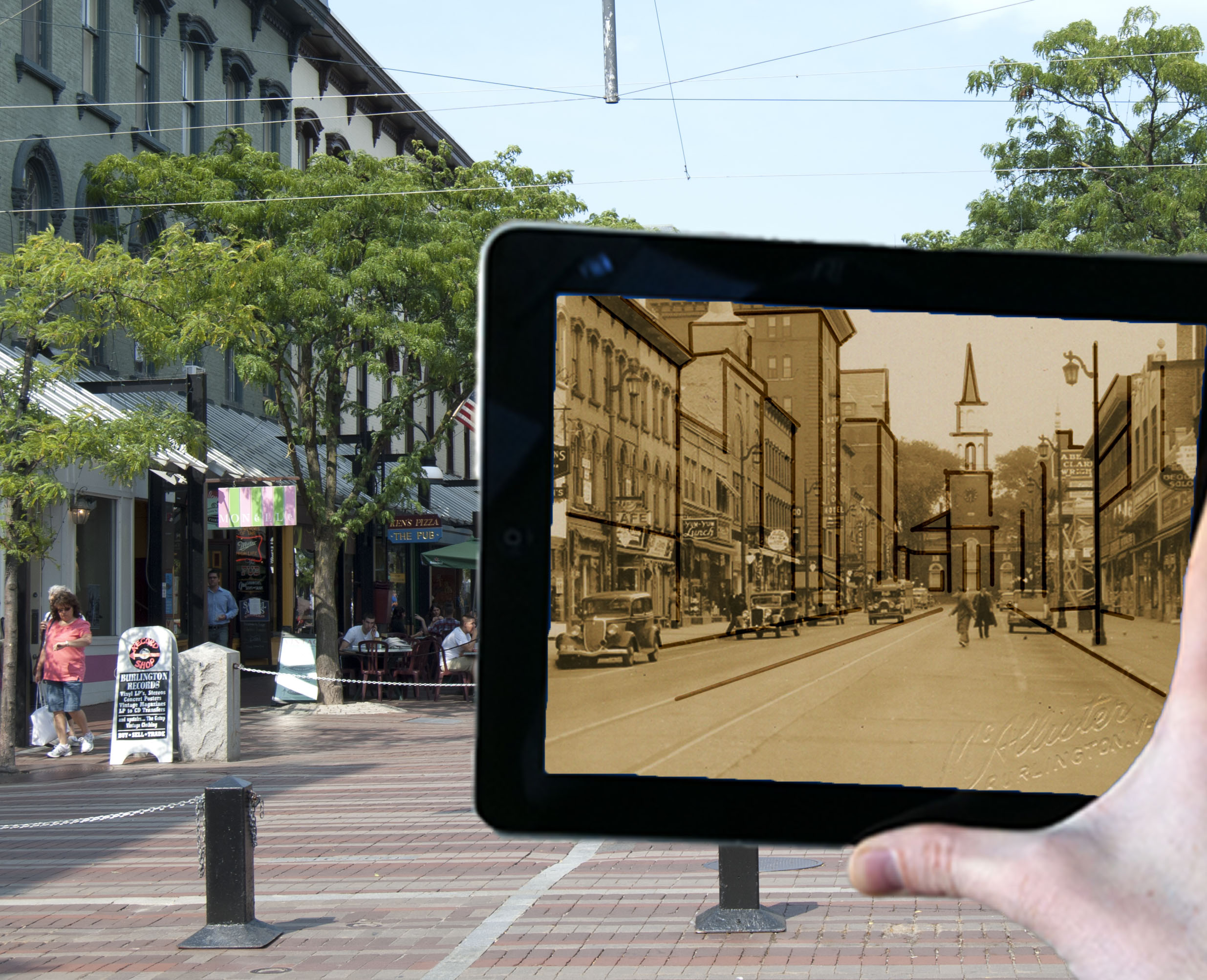 The project incorporates the development method of Agile Development. Start with the big picture and work on cycle of asking question, ideate, prototype, test, refine. Each iteration test a major part of the overall vision. At anytime the project reflects a level of completeness. Features are added as the project gets more refined. The process is engineered for flexibility, so if at any time you need to deviate or explore new directions that emerged or discovered during the concept design and prototyping phases. For feedback, I created a vertical slice (working prototype that shows features). Recent testing prototype with a walking tour group showed promise.
The project incorporates the development method of Agile Development. Start with the big picture and work on cycle of asking question, ideate, prototype, test, refine. Each iteration test a major part of the overall vision. At anytime the project reflects a level of completeness. Features are added as the project gets more refined. The process is engineered for flexibility, so if at any time you need to deviate or explore new directions that emerged or discovered during the concept design and prototyping phases. For feedback, I created a vertical slice (working prototype that shows features). Recent testing prototype with a walking tour group showed promise.
I am also following the trend of the Call of Web 2.0 and it’s expectation to have users arrange, direct, produce, curate, comment, upload all means of cultural production. Can everybody be a storyteller? How about a historical interpreter? In the new virtual world do real object really matter? Can the real and virtual worlds learn from each other and be in a dynamic dialogue?
Seeking to connect present day society to past history. Is this a new avenue of exploration for the organization. What is the nature of the audience experience. preservation what were the interpretive elements presented in conjuncture with the work. Did they help develop audiences for the site. Experiential and group dynamics. Involving partners and collaborators. Nature of the relationship. Expectations and historical retrieval of artifacts. Who is the target market and how were they reached? How to market project?
Methodology
Creating an exhibit and a platform at the same time. Pay attention to the different roles of provider of content and designer of experience to the role of facilitator of experience and content. Matthew MacArthur speaks to the role of objects in the digital world - Artifacts that would otherwise be hidden away in storage are reclaimed and rejuvenated by gaining a second life as digital objects.(?) Museums function of repositories of reference material, place of public education and preservers of the collective memory. The main methods include social engagement, shared authority, facilitating learning and the concept of curation all while maintaining the artistic integrity and vision. Overarching goal of being participatory and inclusive but not at the expense of creating an artful, beautiful and rich engaging experience. Encompassing memory.
Pursuit of “civic engagement” with the local community. research users’ behaviors, observe the interaction attitudes and expectations. Power of building interactive relationships between cultural organizations and audiences. Creating meaningful relationship between the artwork of object and the visitor. Have people participate by contributing to a curated framework that ensures that the whole has an artistic integrity and a vision that can incorporate disparate elements. Laura Koloski envisions ‘combined expertise’ - an approach to collaboration in which practitioners from different fields not only share there skill but open themselves to varied perspectives and values of different disciplines. (Frischer 13)
Looking at the idea of authorship and shared authority. Join in the discovery with the viewers and work to supplement content, interpret, and find meaning. Creation of content using other collections of information. History - more fluid view of history as a collection of truths. Embrace multiple perspectives. Historians and curators - Speculation and educated guesswork goes into filling in the blanks - detective work. The same facts of objects interpreted through a variety of lenses, take on greater meaning and deeper significance. Museum professional supplement content knowledge - interpreting, facilitating, engaging, listening and learning with visitors (audience).
Facilitate learning, a term in the broadest sense - refer to any desired changes within the individual, group, or community including knowledge, disposition, attitudes, behaviors, relationships, modes of communication and skills. What sort of interactive features could encourage participation from the community? Providing a public forum for visitors to ask questions. Museums Goal of trying to engage people and excite, enlighten and educate. Creating off-path experiences that might surprise, provoke, or challenge preconceptions. Learning around cultural artifacts. Learning Sciences - Multidiscipline psychology, cognitive science, computer science, sociology, anthropology, linguistics, and education. Understand the process of learning and applying knowledge to formal and informal learning environments. (Frischer, 197)
Learning from the public curation framework discussed in Public Curation: From Trend to Research - based Practice by Tom Satwicz and Kris Morrissey (200)
- Experience excitement, interest and motivation to learn about the people, ideas, and events of our world.
- Generate, understand, and use concepts, explanations, arguments, and facts to explain history.
- Manipulate, test, explore, predict, question, observe and make sense of change over time.
- Reflect on history as a way of knowing and learning about oneself. One’s relationship the the world around one, and one’s connections to the worlds that came before
- Participate in historical research, interpretation and inquiry with others using language and tools of historical inquiry
- Think about themselves as history learners and develop an identity as someone who know about, uses, and can contribute to historical record and process.
There is a call from museums - inviting audience to chart their own paths; path breaking projects have tried to remove barriers to participation, to invite exploration, and enable audiences to draw connection, make meaning, and share reflections.
Prototype I
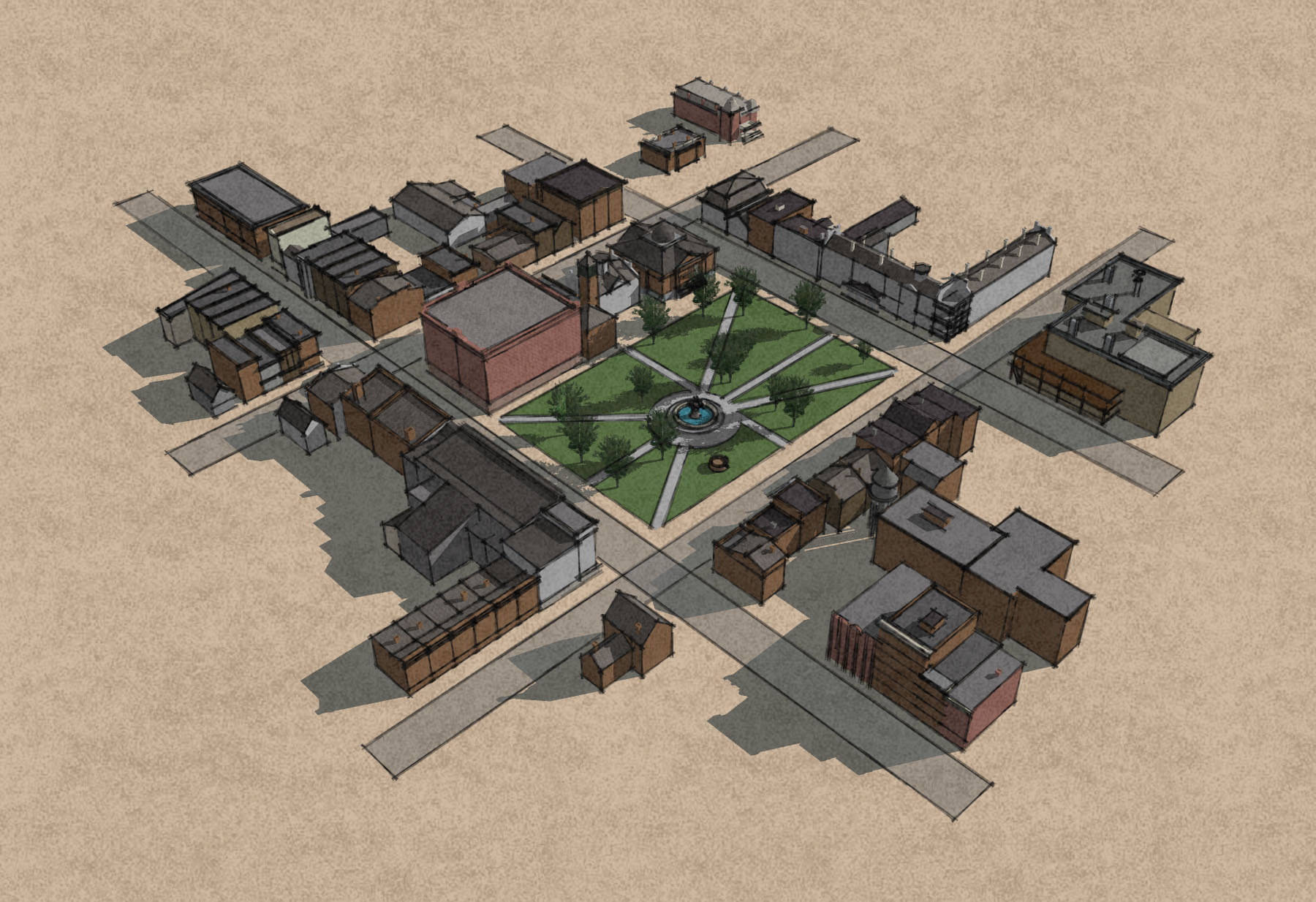 The initial prototype involve recreating city hall park in the year 1890. The reference material included archived photography, postcards, maps, and illustrations. Other publications were used to find out about when buildings existed, who owned them, the dimensions and details about materials, who designed them and what their purpose was. Gathering resources. I found that people love taking pictures of the Unity Church at the top of Church Street but very few take a photo looking south down Church Street. Difficulty in finding certain pieces of information like back sides of buildings, roof top details, colors.
The initial prototype involve recreating city hall park in the year 1890. The reference material included archived photography, postcards, maps, and illustrations. Other publications were used to find out about when buildings existed, who owned them, the dimensions and details about materials, who designed them and what their purpose was. Gathering resources. I found that people love taking pictures of the Unity Church at the top of Church Street but very few take a photo looking south down Church Street. Difficulty in finding certain pieces of information like back sides of buildings, roof top details, colors.
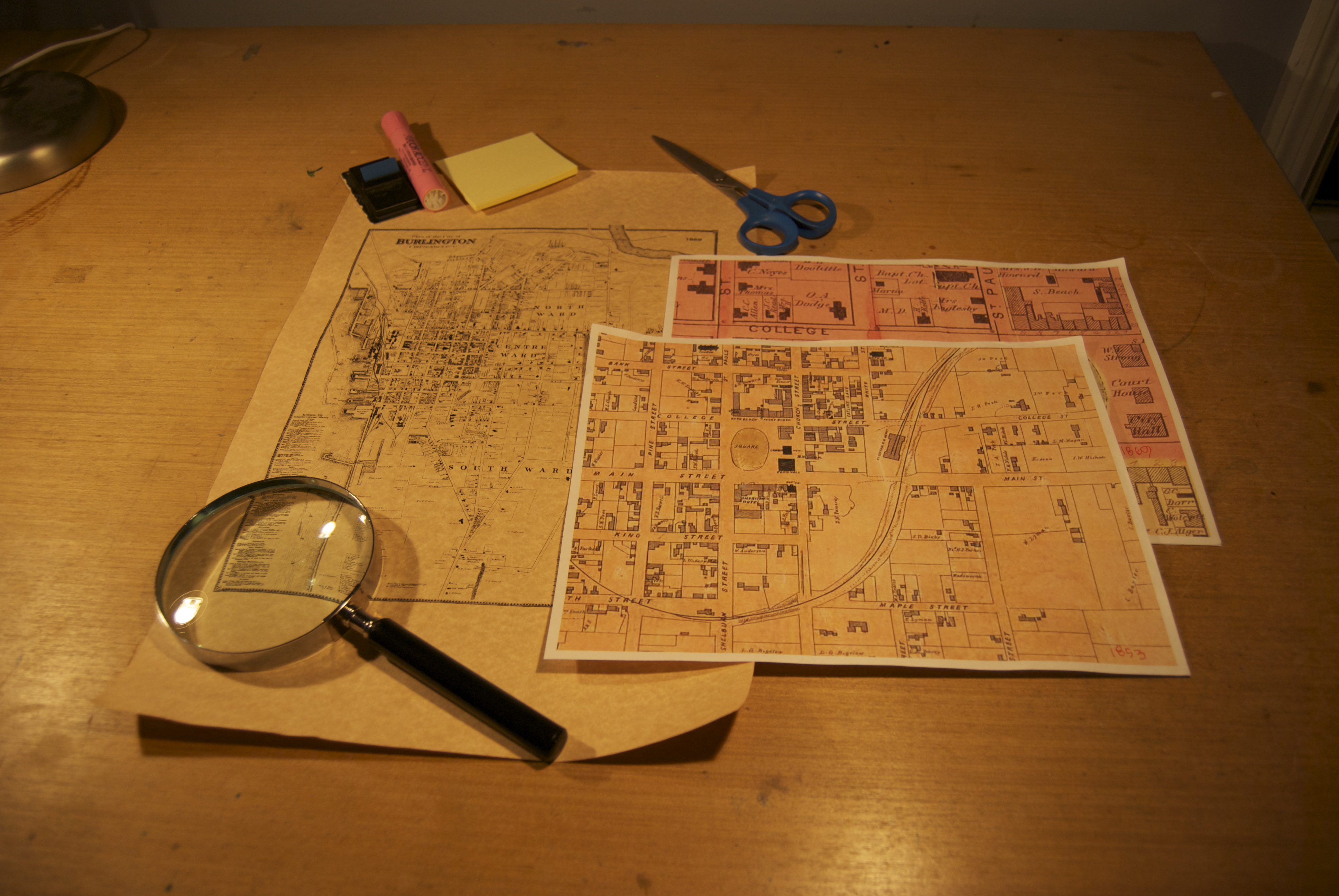 Connection with Library, Champlain College Collection, City Hall. process of finding the right time period. Enough solid references (photo or written description), make sure there was some historical value to choice, possible educational value. Connections to local historians and artist. Reference UVM Project of choosing time period and history students. What resources they used.
Connection with Library, Champlain College Collection, City Hall. process of finding the right time period. Enough solid references (photo or written description), make sure there was some historical value to choice, possible educational value. Connections to local historians and artist. Reference UVM Project of choosing time period and history students. What resources they used.
The process allowed me to learn the software, test the level of detail that can be achieved, the ability to adjust the look and feel through the style menu, test the file size limitations.
Used the prototype to gain excitement in the project and to get feedback from the community on who to make the experience better or features they would like to see. The end result was very stylized in the modeling as well as the treatment. The model was built perfectly to scale using official sources for measurements. The final execution was beautiful and intriguing because to the interactive quality of it, but it lacked any heart. There were no people or story. Also what was it? A tourist attraction, an interactive toy, or an educational tool.
Prototype II
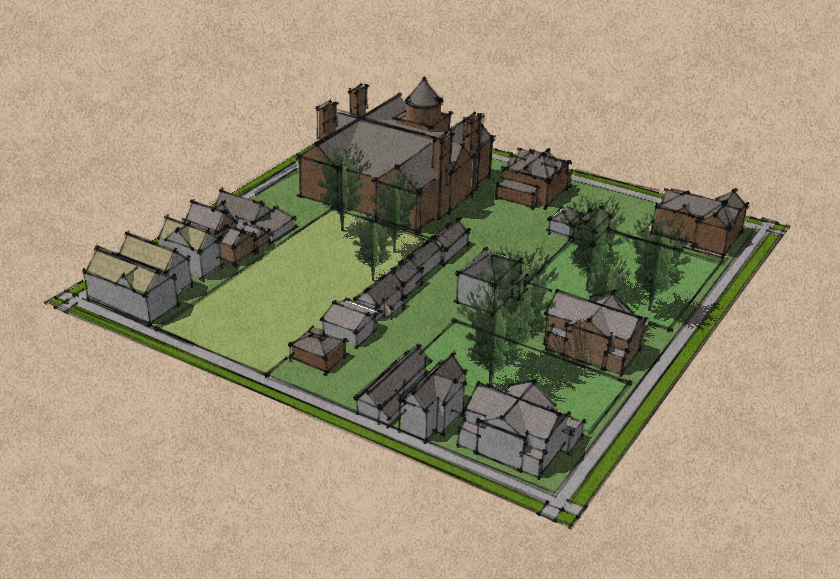 The second prototype is a recreation of Burlington’s ‘Little Italy’ in 1960. A neighborhood made up of an immigrant population that was wiped out during urban renewal project of the 1960s. The area is made up of Battery Street, Pearl Street, St. Paul Street and College Street. The city was embarking upon a new era with long awaited urban development in its inner city. Political and business leaders recognized that a federally financed urban renewal project was their change to clear out what they believed to be slums, attract business and raise the city property tax base. (Historical Guide to Burlington Neighborhoods, Chittenden County Historical Society, 1991
The second prototype is a recreation of Burlington’s ‘Little Italy’ in 1960. A neighborhood made up of an immigrant population that was wiped out during urban renewal project of the 1960s. The area is made up of Battery Street, Pearl Street, St. Paul Street and College Street. The city was embarking upon a new era with long awaited urban development in its inner city. Political and business leaders recognized that a federally financed urban renewal project was their change to clear out what they believed to be slums, attract business and raise the city property tax base. (Historical Guide to Burlington Neighborhoods, Chittenden County Historical Society, 1991
Known as the Champlain Street Urban Renewal Project. A plaque commissioned by the Vermont Division for Historical Preservation in 2011 at the foot of Cherry Street in the Battery Park extension reads:
Little Italy : The Champlain Street Urban Renewal Project Burlington Vermont 1964
Beginning in the early 1900s, the area directly to the east housed numerous emigrants. Many moved here from Italy with hopes to build better lives. Some worked for the lumber mills and railroad yards that bordered the lake. In the process, they created a community of over 140 homes, lush gardens, thriving businesses, community social centers and Catholic schools and churches.
In the 1960s this area became the center of Vermont’s largest urban renewal project. The final home was razed in 1968. Displaced families were scattered into the outskirts of Burlington. In place of this once vibrant family neighborhood stands a dynamic downtown district, internationally known as a social and economic center of Vermont.
Patrick Farrington explored the question imagine being forced out of your home to make way for commercial development. Families living in the Champlain Street Urban Renewal Area. A seemingly forgotten piece of Burlington history. Listening to the heart felt interviews with former residence and individuals near the project. I knew this was a worthy cause.
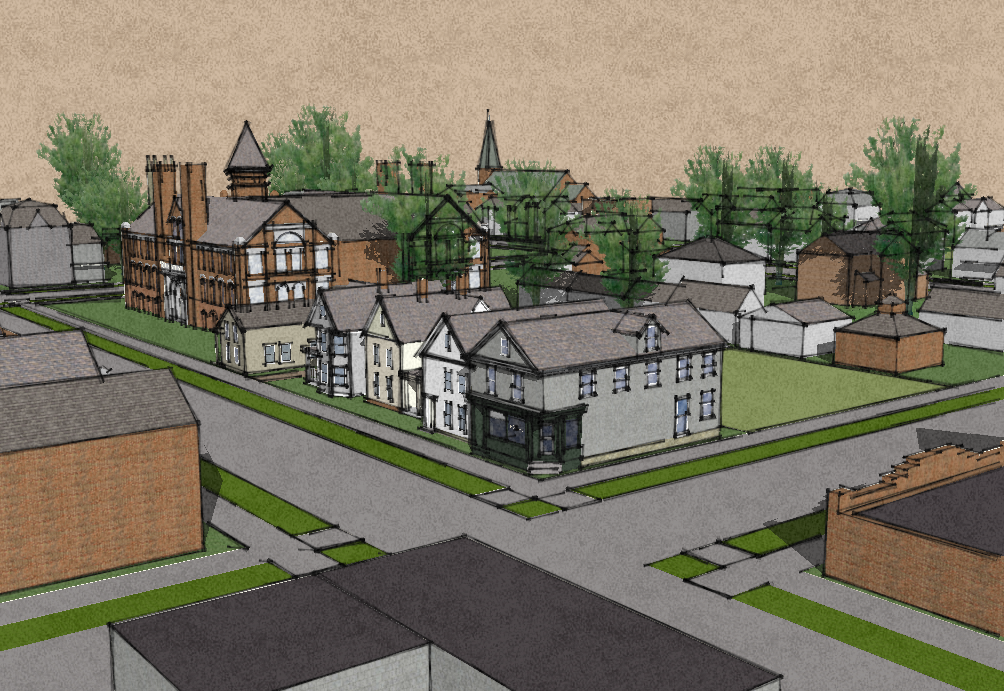 The scale is much bigger than the first iteration. I have chosen to build a complete low resolution version of the area and then chose a smaller area to create a prototype to show level of detail, materials, and sample navigation.
The scale is much bigger than the first iteration. I have chosen to build a complete low resolution version of the area and then chose a smaller area to create a prototype to show level of detail, materials, and sample navigation.
Features include information about the locations, addresses, owners, tenants. The geo spacial execution will include embedded images, audio recordings, and video capabilities. The Vermont Italian club has chosen four main themes that will be addresses. Family, Church, Merchants, and Food. Future work will include creation of iconography to simplify UI.
Other works tackling the subject of government intervention The Black Bottom: Making Community Based Performance in West Philadelphia by Billy Yalowitz (Adair, 156 - 173) urban renewal project in Philadelphia where a poor urban area was wiped out to make room for Penn to expand their campus. Different priorities of a city matches our local history when the community that starts to appreciate Lake Champlain as a natural resource. As the shift from trade to tourism occurs, once undesirable neighborhoods become very valuable.
Motivated by BTV Design: Action and outreach by city and participation in an architectural scavenger hunt with focus on building details brought me to the City of Burlington’s Planning and Zoning. They helped focus my attention to stylistic changes based on movements like Art Deco, and Modernism. As a gift for their help, I created Loss of Character (inset example). The project showed how incremental and subtle changes to the facade of buildings erodes the historical character of the building. The prototype tested the ability to create animation to show change over time.
Another project called Open House: If These Walls Could Talk by Benjamin Filene (Adair, 142) started as an effort to give voice to forgotten people in history presented by Minnesota History Center. The exhibition told the story of a single ordinary house and the families who made their live is in. The amazement of seeing the before and after photos of when it was originally built. Beautiful ornament, detail, proportions, open porch, etc. This tool would perfectly compliment the piece.
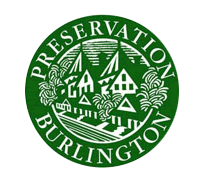 I love the cultural outreach and community aspect of the project. Working collaboratively in multi-generational, virtual and cross-functional team help gain insight I would not have found in a strict scholarly approach. I have learned so much from them and they have been extremely generous with their time, resources , and teaching me about the people that made up the neighborhood. Stories of families living with doors unlocked and the community involved in all aspects of life; the following phrases came up multiple times, that it takes a village to raise a child and that you had everything you needed right in the area. I feel that the description of buildings being sacrificed is apropos. How can we use social media to get the word out, build excitement? In the cycle of sharing models and getting feedback has already started to build buzz and the technology angle is key.
I love the cultural outreach and community aspect of the project. Working collaboratively in multi-generational, virtual and cross-functional team help gain insight I would not have found in a strict scholarly approach. I have learned so much from them and they have been extremely generous with their time, resources , and teaching me about the people that made up the neighborhood. Stories of families living with doors unlocked and the community involved in all aspects of life; the following phrases came up multiple times, that it takes a village to raise a child and that you had everything you needed right in the area. I feel that the description of buildings being sacrificed is apropos. How can we use social media to get the word out, build excitement? In the cycle of sharing models and getting feedback has already started to build buzz and the technology angle is key.
Features
Three different ways of interfacing with prototype.
Use Google Sketch Up or Sketch Up Viewer. With this software you can create fly throughs, planner views, cross-sections, mimic real world lighting and shadows. Download model and navigate with personal computer. sketchup.google.com.
Augmented Reality I - You download a file containing the model. Once you find a custom markers, you scan using an app called AR Player (Available free from iTunes) which super-imposes architectural models over real world and allows user to zoom in and rotate buildings. You need a smart phone or computer with webcam. For more info - www.inglobetechnologies.com
Augmented Reality II - Placing 3D objects on a map using GPS. With a smartphone and an app called 'Layar' you can view the virtual building in the original location. For More information visit www.layar.com
Future
Completion of entire nine blocks. The area includes the addition of the top blocks which housed two historic churches that burned within years of each other around the time of urban renewal.
Collection of more artifacts for supplementing the story elements and creation of iconography for User Interface.
Create a self contained app and website to house process and model as well as additional information, connection to the databases and resources about historical preservation and enhanced augmented reality experience.
Public viewing include two art shows with artifacts and direct interaction with prototype during a neighborhood walking tour in late May. The third prototype will include a complete AR experience for the october presentation of the commemorative plaques that were commissioned by the Vermont Italian Club in October.
Look to the future and layer on what exist right now as well as telling the alternate history of some of the proposals. What there visions were and talk about what didn’t work. Why did the development not occur?
Explore additional executions including 3D printing none marker based image recognition software and animation. Semantic context - Have to be at the location to gain a greater sense of the communication and media. Would this experience be diminish by having it viewed in other platform or be strengthened by allowing multiple levels of access. Use software to control viewing distance. Models / artifact appear. Set up scenario to test different executions.
Creation of learning kits for students and museums to utilize.
Creation of a guided experience with elements of play and participation beyond initial reaction to AR components. Incorporate game mechanics by possibly merging the first and second prototype in unique way.
Conclusion
Agile development was key to accomplishing the project. The process of inquiry, concept and design, rapid prototyping, testing and reiterating helped define the scope of the project. The process has the benefit having a working low fidelity prototype you can show and get feedback.
I thought about how contemporary historical scholarship should be incorporated into the project and what other types of scholarship might be involved in the exploration. To help, I used the idea of public curation to help frame the work. To help exhibit the work, I explored multiple perspectives and different tools. I hope his project uncovers histories that have yet to be told.
The possibilities to continue process and add new stories, area, histories, and time are endless. Goals of participatory media and implementation of collaboration were met by engaging the community, listening to their stories, collecting their memories and creating an appropriate solution to their problem.
Excitement about the process drives a lot of the discovery. I found a solution that satisfies creation of an environment and experience that carry a sense of history about it while maintaining a good balance of artist quality, innovative technology and adhering the the framework of public curator in presentation an exhibit about an important time in history.
The creation of a tool that can be used to make a difference. Telling important stories in a way that the interface and interactive nature of the project are enhanced by the successful use of technology like augmented reality. The power from the emotional and physical reaction of being in the actual space is hard to duplicate through purely digital means. The technology is coming, Will you embrace it? Be creative? Use it to make a difference?
The idea that the homes were ‘sacrificed’ for the better good. A story that needs to be told and the families of those displaced deserve our respect and gratitude. Italian Club originator had a wish of Dr. Ciongoli to have this bygone neighborhood designated publicly so that now and into the future this once vibrant community would be remembered. I hope this helps make that wish come true. In this busy world where everybody is looking at their mobile devices and disconnecting with the people and environment around them, I find myself focused more clearly on the beauty that comes from simple design and ornamentation. When I walk through a residential neighborhood instead of escaping to the iPod, I find myself looking up and admiring all that is around us.
Bibliography
- Adair, Bill, and Benjamin Filene, and Laura Koloski. Letting Go: Sharing Historical Authority in a User-Generated World. The Pew Center for Arts & Heritage, 2011. Print.
- An Azavea and City of Philadelphia Department of Records White Paper. Augmented Reality: Implementing Mobile Augmented Reality Technology for Viewing Historical Images, PhillyHistory.org, 2011. Print.
- Blow, David. Historic Guide to Burlington Neighborhoods Chittenden County Historical Society, 1991. Print.
- Blow, David. Historic Guide to Burlington Neighborhoods Vol. II. Chittenden County Historical Society, 1997. Print.
- Frischer, Bernard. New Directions for Cultural Virtual Reality: A Global Strategy for Archiving, Serving, and Exhibiting 3d Computer Models of Cultural Heritage Sites. Institute for Advanced Technology in the Humanities, University of Virginia, 2005. Print.
- Farrington, Patrick. The Champlain Street Urban Renewal Project. Ponderosa Publishing, 2002. Video DVD.
- Frischer, Bernard. The Rome Reborn Project: How Technology is Helping Us Study History. University of Virginia, 2008. Print.
- Murray, Janet H. Hamlet on the Holodeck: The Future of the Narrative in Cyberspace. M.I.T. Press. 2001. (Originally published by the Free Press, a Division of Simon & Schuster Inc. 1997). Print.
- Presented by The Burlington Free Press. Champlain Valley Memories: The Early Years, Pediment Publishing, 2002. Print.
- Presented by Burlington Free Press. Champlain Valleys Memories: Volume II - The 40’s, 50’s and 60’s Pediment Publishing, 2003. Print.
- Riccio, Anthony V. Italian American: Experience in New Haven. State University of New York Press, 2006. Print.
- Robinson, David E. and Mary Ann DiSpirtito. Images of America: Burlington, Arcadia Publishing. 1997, Print.
- Robinson, David E. and Mary Ann DiSpirtito. Images of America: Burlington II. Arcadia Publishing. 1999, Print.
- Roseburry, Dinah & Mary Martin. Greetings From Burlington. Schiffer Publishing. 2007, Print.
- Burlington Free Press, January 27, 1972. Newspaper.
- Burlington Free Press, January 25, 1972. Newspaper.
- Burlington Free Press, August 26, 1968. Newspaper.
- Burlington Free Press, June 17, 1968. Newspaper.
- Burlington Free Press, January 23, 1997. Newspaper.
- Burlington Free Press, March 28, 1961. Newspaper.
- Seven Days, Downtown Phantoms: A new plaque marks Burlington’s lost Italian Neighborhood, October 5, 2011. Newspaper.
- Seven Days, WTF: Just What is Augmented Reality? Ken Picard. October 26, 2011, Newspaper.
- Landscape Change Program. University of Vermont - National Endowment for the Humanities http://www.uvm.edu/landscape/ Collection.
- The Llewellyn Collection - Champlain College. Collection.
- Community Portrait: Italian Professional Women, Channel 17, 1997. Television.
- Italian Culture Association: Channel 17 Interview with Adele Dienno and Joe Maietta, 1999. Television.
- Little Italy Dedication & Celebration Preview, Channel 17, 2011. Television.
- What it Means to be Italian: VICA Gathering at Sand Bar Park, 2001. VHS.
- G. M. Hopkins Map. Burlington, Vermont 1890. Map
- Sanborn Fire Map. Burlington Vermont 1921. Map.
Resources
- Burlington Department of Planning and Zoning http://www.burlingtonvt.gov/PZ/Historic-Preservation/
- Preservation Trust of Vermont www.ptvermont.org/
- Historical Preservation Program: University of Vermont http://www.uvm.edu/~histpres/
- Vermont Division for Historical Preservation http://www.historicvermont.org/
Contributors
- Vermont Italian Club Adele Dienno, John Varricchione, Monica Farrington, Louis Izzo, Joseph Maietta, Val Zarro, and Terri Burrell
- Burlington Department of Planning and Zoning Sandrine Thibault, Mary O’Neil, and Nic Anderson, and David White
- University of Vermont - Bailey Howe Library - The Wilbur Special Collections
- Fletcher Free Library - Local History Room
- Vintage Inspired Lifestyle Marketplace - Mary Heinrich Aloi www.VintageInspired.net
- Upstairs Antiques - David Robbins
- Burlington Walk-Bike Council - Wayne Senville
- Sona Writes - Sona Iyengar
- Champlain College - Al Larsen, John Banks, Ken Howell, Jeff Rutenbeck, Ann DeMarle, and Erik Esckilsen